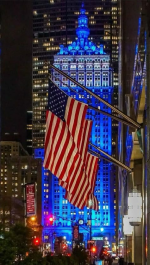The most populated city in the United States is New York City (NYC), with a population of approximately 8.3 million people as of the latest estimates.
Cultural Center – Broadway, museums, music, and diverse communities.
Historical Significance – A symbol of American resilience and immigration.
Tourism & Media – Times Square, Central Park, and the headquarters of major news outlets.
It grew through trade, immigration, and industrialization, becoming the U.S.’s largest city.
Today, it remains a global powerhouse in finance, culture, and innovation.
Would you like details on specific events, like the 9/11 attacks or Ellis Island immigration?
Why Is New York City So Populated?
- Economic Opportunities – NYC is a global financial and business hub (Wall Street, major corporations).
- Cultural Diversity – A major destination for immigrants and home to over 180 nationalities.
- Tourism & Landmarks – Attractions like Times Square, Central Park, and the Statue of Liberty.
- Education & Innovation – Home to top universities like Columbia and NYU.
- Historical Significance – A key entry point for immigrants in the 19th and 20th centuries.
History of New York City: The Most Populated City in the U.S. ️
New York City (NYC) has a rich and complex history, evolving from a small Dutch settlement into one of the most influential cities in the world.1. Early History & Colonial Era (Pre-1600s – 1776)
Native American Inhabitants (Pre-1600s)
- Before European arrival, the Lenape people lived in the NYC area, calling it "Lenapehoking."
- They fished, hunted, and traded in what is now Manhattan, Brooklyn, and the surrounding regions.
Dutch Settlement: New Amsterdam (1624-1664)
- In 1624, the Dutch established a fur trading post on Manhattan Island, naming it New Amsterdam.
- Peter Minuit famously "purchased" Manhattan from the Lenape in 1626 for goods worth about $24 in today's money.
- The settlement became a thriving port and economic center.
British Control: New York (1664-1776)
- In 1664, the British took control from the Dutch and renamed it New York after the Duke of York.
- The city grew rapidly as a trading hub, attracting immigrants from England, the Netherlands, and beyond.
- By the 1770s, New York was a major center of commerce and culture in the American colonies.
2. Revolutionary War & 19th-Century Growth (1776 – 1900)
Role in the American Revolution (1776-1783)
- New York was a key battleground during the American Revolution.
- The British occupied NYC from 1776 to 1783 before George Washington's troops reclaimed it.
Immigration Boom (1800s – Early 1900s)
- NYC became the main entry point for immigrants through Ellis Island (opened in 1892).
- Over 12 million immigrants, mainly from Ireland, Italy, Germany, and Eastern Europe, passed through Ellis Island.
- The Statue of Liberty, dedicated in 1886, became a symbol of freedom and opportunity.
Industrialization & Skyscrapers (Late 1800s – Early 1900s)
- NYC’s financial sector (Wall Street) expanded, making it the financial capital of the U.S.
- The city’s skyline began to grow with early skyscrapers like the Flatiron Building (1902).
- Subways (1904) and bridges (Brooklyn Bridge, 1883) connected the boroughs, helping the city expand.
3. The 20th Century: The Rise of a Global Power (1900-2000)
The Roaring Twenties & Great Depression (1920s-1930s)
- NYC became a cultural hotspot during the Jazz Age.
- The Great Depression (1929) hit hard, but the city rebounded with major infrastructure projects.
World War II & Postwar Boom (1940s-1950s)
- NYC was a key economic & military hub during WWII.
- After the war, it became the headquarters of the United Nations (1945), reinforcing its global importance.
Civil Rights, Immigration, & Cultural Movements (1960s-1990s)
- The city played a major role in the Civil Rights Movement and LGBTQ+ rights (Stonewall Riots, 1969).
- Immigration surged, making NYC one of the most diverse cities in the world.
- The World Trade Center was completed in 1973, symbolizing NYC’s economic power.
9/11 Attacks & Rebuilding (2001 – Present)
- On September 11, 2001, NYC faced the deadliest terrorist attack in U.S. history.
- The World Trade Center collapsed, but the city rebuilt with the One World Trade Center (2014).
4. Modern New York City (2000s – Present)
- NYC remains the largest city in the U.S., with over 8.3 million residents.
- It is a global leader in finance, fashion, entertainment, and technology.
- The city continues to evolve, facing challenges like housing costs, climate change, and economic shifts.
5. Why Is NYC So Important?
Financial Hub – Home to Wall Street and the New York Stock Exchange.Cultural Center – Broadway, museums, music, and diverse communities.
Historical Significance – A symbol of American resilience and immigration.
Tourism & Media – Times Square, Central Park, and the headquarters of major news outlets.
Final Summary
New York City began as a Dutch settlement (New Amsterdam) in 1624.It grew through trade, immigration, and industrialization, becoming the U.S.’s largest city.
Today, it remains a global powerhouse in finance, culture, and innovation.
Would you like details on specific events, like the 9/11 attacks or Ellis Island immigration?




